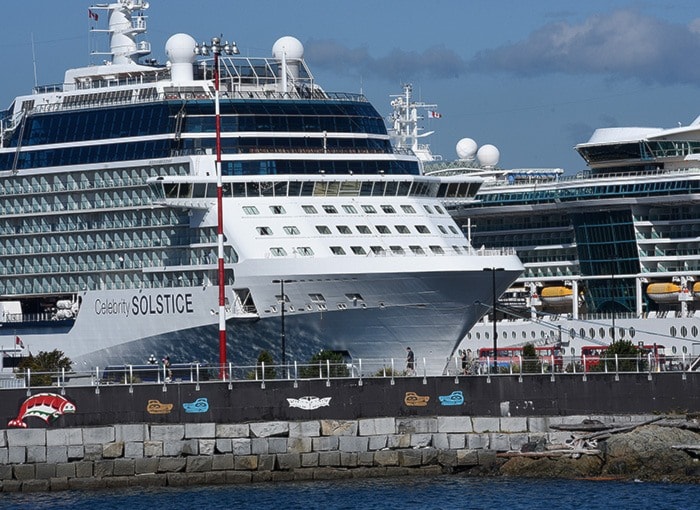While emissions from cruise ships have been reduced over the past year, more still needs to be done to improve air quality in James Bay, according to the local neighbourhood association.
According to a report released by the Ministry of Environment, sulphur dioxide emissions have decreased in 2015 compared to the previous year.
Through a regional air quality monitoring station at Topaz Avenue and Erie Street, set up in 2006 and 2009 respectively, meteorologists looked at sulphur dioxide levels when cruise ships were in port versus when they were not in port.
In James Bay with no cruise ships, meteorologists recorded 34 micrograms per cubic metre of sulphur dioxide in the community (other modes of transportation such as trucks, the MV Coho and ferries emit sulphur dioxide as well) and 40 micrograms per cubic metre at the station on Topaz Avenue.
In 2009, there were 120 hours during the cruise ship season when sulphur dioxide levels exceeded the baseline of 34 micrograms per cubic metre recorded at the Erie Street station. However that number was significantly reduced to seven hours in 2015. There was also a similar trend at the Topaz station as well.
“Hourly or daily objectives haven’t been exceeded and the World Health Organizations objectives were not exceeded for the 10 minute levels and the daily levels. That’s really good news,” said Earle Plain, air quality meteorologist with the Ministry of Envrionment. “We’ve seen a positive trend and last year we complied with all the air quality objectives of the World Health Organization and the province.”
According to the report, the reduction in emissions is due to a shift to cleaner fuel or the installation of scrubbing technology on cruise ships that use sea water to reduce sulphur dioxide emissions.
The call to reduce emissions originally came in 2006 after the James Bay Neighourhood Association reached out to the Vancouver Island Health Authority over health concerns. Shortly after, the ministry partnered with the Greater Victoria Harbour Authorit, Island Health, the neighbourhood association and researchers at the University of Victoria to monitor sulphur dioxide emissions.
The neighbourhood association said the recently released results are good, but not new.
“It does show what we knew, which is the sulphur dioxide issue is almost resolved. But that is not the total emissions issue,” said president Marg Gardiner.
“People still see black smoke. But beyond that, every once in a while people are engulfed with some emissions . . . We don’t know the health impacts of those emissions or if there are any or not.”
Gardiner hopes the harbour authority will work to reduce all emissions from float planes, helicopters, buses and cruise ships, which may prove more difficult since the technology to monitor and measure those emissions are not as advanced, she noted.
Sonterra Ross, chief operating officer with the harbour authority, said it has worked to reduce the amount of emissions in the area recently. This year, the harbour authority implemented a fee to incentivize the use of new technologies, primarily in buses. The harbour authority promotes walking off the terminal and using rickshaws or pedicabs to get to downtown Victoria as well, Ross added.
Plain said they will continue to monitor air quality levels at both stations and noted the levels should continue to decrease or remain the same as more companies move to newer technologies.
For more information about hourly air quality readings in James Bay visit bcairquality.ca.
